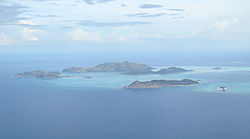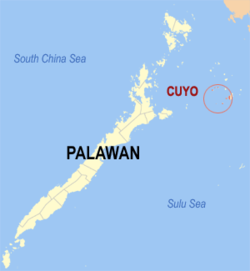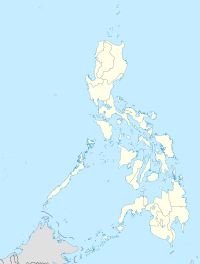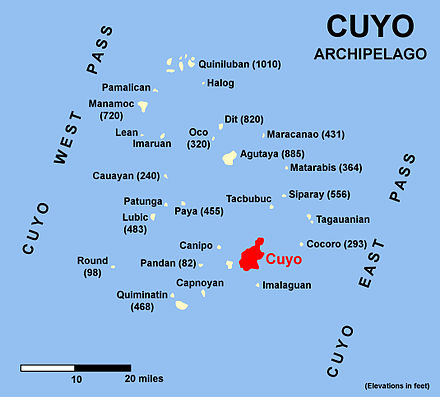- Cuyo, Palawan
-
Cuyo — 4th class municipality — The Quiniluban island group, in the extreme north of the Cuyo archipelago. Map of Palawan showing the location of Cuyo Location within the Philippines Coordinates: 10°51′N 121°01′E / 10.85°N 121.017°ECoordinates: 10°51′N 121°01′E / 10.85°N 121.017°E Country Philippines Province Palawan Population (2000) - Total 18,257 Cuyo is a 4th class municipality in the province of Palawan, Philippines. According to the 2000 census, it has a population of 18,257 people in 3,609 households.
During the Spanish colonization of the Philippines, Cuyo became the second capital of Palawan from 1873 to 1903.[1]
The municipality is served by Cuyo Airport.
Contents
Barangays
Cuyo is politically subdivided into 17 barangays. In 1956, sitio Danawan was elevated into a barrio.[2]
- Balading
- Bangcal (Pob.)
- Cabigsing (Pob.)
- Caburian
- Caponayan
- Catadman (Pob.)
- Funda
- Lagaoriao (Pob.)
- Lubid
- Manamoc
- Maringian
- Lungsod (Pob.)
- Pawa
- San Carlos
- Suba
- Tenga-tenga (Pob.)
- Tocadan (Pob.)
Cuyo Group of 45 Islands
Main article: Cuyo ArchipelagoCuyo Island Group is a group of 45 islets with a total land area of 50 square miles (130 km2). It lies south of Mindoro and between Northern Palawan and Panay. The biggest island in this group is Cuyo with an area of 22 square miles (57 km2) and is about 9 miles (14 km) long. Cuyo is divided in three municipalities, namely Cuyo, Agutaya, and Magsaysay. Cuyo is the oldest town in Palawan which has a culture of its own and was preserved for more than 350 years. In the year 2008, the total population of the Cuyo Island is almost 25,000. Cuyo is divided into two island groups. Up north is the Quiniluban group to which Pamalican island. To the south are the Cuyo islands, where the three municipalities namely Cuyo, Agutaya, and Magsaysay are located.
Cuyo Island
An hour and 30 minutes by air and 24 hours by sea from Manila, Cuyo is a fourth-class municipality composed of 17 barangays. With a population of 18,257 people (2000 census), it is one of the unexploited islands in the country. Home to a fort, which shelters a church and a convent in its high stone walls, constructed during the Spanish period to protect its population from Moro pirates, Cuyo has one of the most ancient forts in the Philippines. Incidentally, Cuyo became the second capital of Palawan from 1873 to 1903.
Access to Cuyo Island (November 2009). Planes from Manila Airport (Terminal Two) to Puerto Princesa or Iloilo. Boat service several times a week from Puerto Princesa and Iloilo to Cuyo Island and back. There are also weekly boat services from Manila to Cuyo Island.
Cuyo Island Airport
Since June 2008 it has not been possible to reach Cuyo Island by plane, although the runway of the existing airport was extended in 2009: Cuyo Airport (IATA: CYU, ICAO: RPLO) is an airport serving Cuyo, a municipality in the province of Palawan in the Philippines. It is one of three airports in Palawan, the others being Puerto Princesa Airport and Francisco Reyes Airport, in the municipality of Busuanga. It is classified as a feeder airport by the Air Transportation Office, a body of the Department of Transportation and Communications that is responsible for the operations of not only this airport but also of all other airports in the Philippines, with the exception of the major international airports.
History
Chinese traders where the first to discover Cuyo island and introduced the trade and barter system in the locality.
Later Chief Matuod of Malay origin arrived in big bancas called "sakayan" and formed settlements on the island of Cuyo. A Malay Mohamedan of the name Datu Magbanua later also settled on Cuyo. Datu Magbanua's leadership was so great and powerful that even chieftains from other islands recognized his rule. The Malays brought with them their dances, and when blended with native dance, the "Soriano", it became known as the "pondo-pondo" one of the most popular folk dances even up to the present.
During the leadership of Datu Magbanua, three Chinese Mandarines arrived on the island and settled also on Cuyo. The Chinese discovered gold deposits in Mt. Aguado and introduced gold mining, smith working, pottery, and other handicrafts. The natives of Cuyo became suspicious of the their presence and were able to drive them out. They sailed to Ilongilong (today known as Iloilo) and formed another settlement called "Parian".
In 1622, Count San Augustin together with five Spanish missionaries colonized the island named by them as Cuyo and introduced Christianity. The friendly character of the people proved to be a blessing to the Spaniards who did not find difficulties in converting the population of Cuyo Island to Christianity. They were immediately able to baptize 500 Cuyonos.
In 1636 a powerful Muslim fleet under Datu Tagul raided Cuyo and other places in Palawan. In Cuyo the Muslim attacked the convent and the church and set the town on fire and took with them prisoners including a priest, Fr. Francisco de Jesus Maria. They then proceeded to Agutaya and Culion and wrought havoc and destruction on the helpless and defenceless civilians. Again their prized captive was another priest from Culion, Fr. Alonzo de San Augustin who was captured while saying mass. A Spanish naval flotilla of 6 vessels and 250 men under Capt. Nicolas Gonzales met the returning pirates with their loot and booty on December 21, 1636. Datu Tagul was killed, 300 of his men captured and 120 prisoners were liberated. The two captured priests were unlucky.
In 1957 the following sitios were converted to barrios: Emilod[3] and Balading.[4]
Cuyo Fort
During the early Spanish period, purposely to protect the Cuyonon from sporadic Moro attacks, Fort Cuyo was constructed and finished in 1680. The original complex of stone and mortar was a square with four bastions. The present complex, which occupies 1 ha, is a solid rectangular edifice with walls 10 m high and 2 m thick. It has a tall belfry and watchtowers; its canons, which face the sea, are now fired only during town celebrations. It is considered as one of the most ancient and unique forts in the Philippines. Unique in the sense that you can find the church, the convent and the Perpetual Adoration chapel all within the fort. In 1762 one of the British ships that invaded Manila fired at the Cuyo fort but it was not damaged at all. Another fort was started at Lucbuan seven kilometres away on the east side of Cuyo island, but it was never finished. In 1873, the capital of Paragua (present day Palawan) was transferred to Cuyo from Taytay.
Cuyo Town
Cuyo is known to be the oldest town in Palawan. From the sea, Cuyo Island's first visible landmark is a lighthouse by the pier. Many of the streets leading to the town have already been cemented but the town has preserved the Hispanic plaza-iglesia structures. Dominating the town centre is Cuyo's 1860 church, convent, and fort built by the Spanish and finished in 1680. Nearby stands a schoolhouse, and a monument of national hero Jose Rizal.
Cultural Heritage
Despite its long history Cuyo has held back the hands of time and preserved its rich cultural heritage preserved since more than 350 years.
The tipano band, a flute and drum ensemble, and the de kwerdas (string band), supply background music on important social occasions. They also accompany singers and render dance music like the pinundo-pundo. The tipano is reserved for the ati-ati, sinulog, and komedya.
Both ensembles use available instruments and instrumentalists. The tipano core is basically two drums and four to seven transverse mouth flutes with six finger-holes. One or two tipano "nga maitley" (small flutes) and three or four tipano "nga mabael" (larger flutes) are played with a redublante (snare drum), bombo (big drum), and sometimes a pair of platilyo (cymbals). The de kwerdas has two or three byulin or sabel (violins), and occasionally a gitara or sista (guitar), a bajo (six-stringed bass), a banjo, and a banduria. In Cuyunon music the akompanimento refers to the harmonic accompaniment-principal or primers to the first or highest voice, and segunda to the second.
The Cuyunon youth celebrate love with song during the post-harvest courting season. The cancion, a popular serenade, is sung with the strumming of a five - or six-stringed guitar in the distinctive punctual manner. Parting is a familiar concern in Cuyunon love songs. Examples of love songs are "Napopongao Ako", "Ang Gegma", "Ploning", "Daragang Taga Cuyo", "Konsomision", "Ako Maski Bayan", "Tiis Manong Pido", "Nagpamasiar Ako", and "Komosta".
Cuyunon dances have evolved from native and Spanish influences. Among these are the pastores (the Christmas dance of the sheppherds), the chotis (from the German schothische), lanceros de Cuyo (local French guadrille), birginia and virgoire (Virginia reel or square dance), paraguanen (a romantic comic duet), and la jota paragua (a Castillan-type jota using bamboo castanets and manton). The island is known for the mazurka de Cuyo, a social dance with characteristic mazurka steps. Another popular dance is the pinundo-pundo, a stylish wedding dance marked by sudden pauses, its first two parts, featuring solo dances of the boy and the girl, are followed by the suring, a love play between the couple. Forms found in other regions, like the kuratsa, pandango, and habaneras have also been adapted by the Cuyunon.
The Cuyunon have developed the art of merging song, dance, and drama. Cuyo's sayaw is a colorful enactment of a story heightened by the music of a string band. It is presented by five pairs of youth arranged in two lines, fully costumed and made up, and bearing props like flowers, crowns, and even knives. After an introductory dance, the leading couple proceed to relate the tale, sometimes using verse. The topic may be anything, from everyday occurrences to special events like winning the sweepstakes. This story is then interpreted in dance and ended with a finale.
Yearly on August 28, Cuyo Island celebrates San Agustin's feast. On the eve of the fiesta, a cultural presentation featuring the traditional performing arts and sometimes a separate show of modern songs and dances may be presented. The feast day is begun with a morning mass (sometimes a High Mass officiated by the bishop ) and followed by the ati-ati, a legacy of the Aklanon. Folk from the nearby islands board barotos (boats) to view the parade which recreates the confrontation of San Agustin and the native "savages". Participants portray the Aeta by darkening their bodies with soot and painting their faces with anyel (indigo). They don foot-high headgear of coconut ginit fiber adorned with chicken feathers, and decorate their costumes with coconut leaves. The men, clad in loin cloths, carry spears, bows and arrows, or bolo. The women, wearing patadyong and beaded necklaces, carry baskets with a tumpline
The participants form two lines, one of men and the other of women. The director signals the start of the singing by striking his cane on the ground. This is followed by a spontaneous dance characterized by sways, hops, jumps, and the jerking of weapons accompanied by chanting; the director also signals the end of the dance. The teniente (barrio head) and his family may recite a series of verses. The director is then approached by the last to recite, customarily the teniente's youngest child.
As the floats of San Agustin and other saints enter the church at the end of the procession, the participants kneel, prostrate themselves, or sing while performing skipping steps before the images. The merrymaking intensifies when the alakayo, a dancing clown, chases the ladies, stopping only when coins are thrown to him on the ground. The alakayo collects the coins with his mouth.
Meanwhile, the panapatan performance are staged in front of various houses for a fee. These are mostly excerpts of the komedya and ati-ati known as komedya sa kalye and ati-ati sa bukid, the performers of which use simpler clothing than in the more elaborate full-length performances. Ati-ati sa bukid is sung and danced to celebrate a fruitful harvest. Today it is usually danced by young boys wearing masks or indigo-painted faces.
Another pantomime, innocentes, recreates the descent of the "savages" from the hills to pay tribute to San Agustin. They are wearing coconut fibre masks and red striped shirts. The participants frolic and fence with sticks.
Komedya or moro-moro performances are larger (with some 50 actors) and more refined than the ati-ati. The clash between the Mustlims and the Christians is further dramatized by background music; commonly used tunes are the pasadoble, marchas, giyera, and kasal.
The same subject is portrayed by the sinulog. The Christians are identified by their black costumes, kampilan, and elongated shields; the Muslims by their red turbans and waistbands, and round shields. The participants may wear masks or paint their faces. Both groups, usually of six dancers each, sometimes perform to the beating of tin cans. Alternate steps of offense and defense, e.g., advancing and retreating, with corresponding movements of weapons, are followed by circular formations simulating scenes of strategy plotting.
Aguado Pilgrimage
Mt. Aguado features life-size Stations of the Way of the Cross constructed from the foot to the peak of the mountain. Cuyonon devotees, visitors and tourists make the annual pilgrimage to Mt. Aguado as part of the penitential rites done in Cuyo during the Holy Week particularly on Holy Thursday.
References
- ^ Official Website of the Province of Palawan. Accessed August 28, 2008.
- ^ "An Act Converting the Sitio of Danawan, Municipality of Cuyo, Province of Palawan, into a Barrio of Said Municipality". LawPH.com. http://lawph.com/statutes/ra1495.html. Retrieved 2011-04-12.
- ^ "An Act Converting the Sitio of Emilod, Municipality of Cuyo, Province of Palawan, into a Barrio of Said Municipality". LawPH.com. http://lawph.com/statutes/ra1750.html. Retrieved 2011-04-12.
- ^ "An Act Creating the Barrio of Balading in the Municipality of Cuyo, Province of Palawan". LawPH.com. http://lawph.com/statutes/ra1769.html. Retrieved 2011-04-12.
External links
Municipalities Highly urbanized city Puerto Princesa
(Administratively independent from the province, but grouped under Palawan by the National Statistics Office)Categories:- Municipalities of Palawan
- Islands of Palawan
- Sulu Sea
Wikimedia Foundation. 2010.




